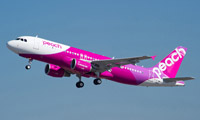Low-Cost Carriers
Flying start for Japan's LCCs
October 1st 2012
With three new low-cost carriers (LCCs) in operation since March the Japanese domestic market is experiencing a tsunami-like transformation. Read More »
 |
| Peach Aviation: up to 30% of passengers during the peak summer holiday season were first-time flyers |
Offering fares often 50%-75% lower than established carriers, the new LCCs have been successfully attracting cost-conscious first-time flyers. Now, the budget carriers are starting to steadily expand as demand picks up.
Shinichi Inoue, the chief executive of Peach Aviation, the first of the trio to take off, pointed out in a recent media interview that during the peak summer holiday season up to 30% of their customers were first-time flyers. They were people who would normally have travelled by inter-island ferry or long-haul bus.
“This shows the new LCCs are not just taking business away from existing airlines, but are creating completely new demand,”said Haruo Ushiba, a principal analyst of Japan Aviation Management Research (JAMR), an industry consultancy.
In the traditional Japanese Bon holiday period in August, almost three million people took domestic flights with Japan’s 13 domestic airlines.
Of these, the three LCC newcomers carried about 3% of the total, or 82,503 passengers, but they achieved outstanding load factors. Peach Aviation, AirAsia Japan and Jetstar Japan reported seat occupancy rates of 94.3%, 91.2% and 89.5% respectively.
All Nippon Airways-backed Peach, flying out of Osaka’s Kansai airport announced at the end of August that since its inaugural flight on March 3 to early last month it had carried 604,103 passengers on its four routes with well above target load factors of 79%.
The carrier is targeting four million passengers in 2013, four times the number estimated for 2012.
Jetstar Japan, a Narita-based venture involving Japan Airlines and Qantas, carried 100,000 passengers between day one on July 3 and August 21, recording an occupancy rate of 86%,
On August 24, Jetstar opened its second hub at Osaka Kansai.
The third of the new LCCs to take off was AirAsia Japan, on August 1. It is another carrier with an ANA interest as well as investment from Kuala Lumpur-based AirAsia. Like Jetstar Japan, it operates out of Narita.
“The new LCCs are stimulating the domestic market, which in recent years has slumped from a record 96 million passengers in 2006 to 77.6 million in 2011,” said JAMR’s Ushiba. “They are also starting to have a knock-on effect in other parts of the travel business.”
The impact can be seen around Narita, where some hotels have packages for LCC customers offering ultra early check-outs and free transport to the airport terminal. Bus companies have launched low-fare late night and very early morning services between central Tokyo and Narita so LCC travellers can catch their flights.
And in Japan, where travel agents have a lot of clout, the budget carriers are cooperating with tour operators to offer low-cost package tours. A Japan Travel Bureau (JTB) Hokkaido tour using Jetstar Japan can be 30% to 50% cheaper than an identical package with one of the legacy airlines.
Ushiba likens the social impact of LCCs to the introduction of the high speed bullet trains in 1964 between Tokyo and Osaka, which created a boom in intercity travel.
“Suddenly, people discovered they could easily make the round trip journey in a day to attend meetings, weddings and other social events. The influence of the LCCs will be similar,” he said.
A day trip to Sapporo – 832 km from Tokyo - is suddenly a feasible proposition for everyone, not just business travellers, thanks to the low fares. Air Asia Japan recently carried a school soccer team from Narita to Sapporo for a one-day tournament.
Peach has attracted day trippers from Osaka to Seoul for shopping trips. Jetstar Japan has flown day trippers to Okinawa.
Almost 50% of AirAsia Japan’s passengers in its first month were retirees, considered a key market by the new LCCs.
Regulatory gripes remain, however. Jetstar Japan’s chief executive, Miyuki Suzuki, regularly compares the position of Japanese regulators to an isolated “Galapagos” situation, citing as an example the transport ministry’s insistence on foreign pilots requiring training to acquire Japanese licences, despite being highly qualified by global standards.
Quick turnaround times, a key feature of the LCC business model, is presently impossible in Japan because of a Japan Civil Aviation Bureau (JCAB) rule preventing passengers from boarding during refuelling.
Help could be on the way. The conservative Ministry of Land, Infrastructure, Transport and Tourism (MLIT) is reviewing about 100 regulations within the financial year after discussing potential changes with airlines.
Narita’s 11pm curfew has also caused problems for the two LCCs based there. Jetstar Japan has been forced to cancel late night flights after running out of time, causing the carrier to spend heavily on hotels for stranded customers.
Ushiba believes Japan’s LCCs will have a 30% market share by 2020. “LCCs are starting to change Japanese travel habits,” he said.
However, Kei Shibata, chief executive and founder of Venture Republic, owner and operator of Japan’s leading online travel search engine, Travel.jp, was even more bullish. Speaking at a recent conference, he predicted LCCs’ market share could reach 50% within five years.